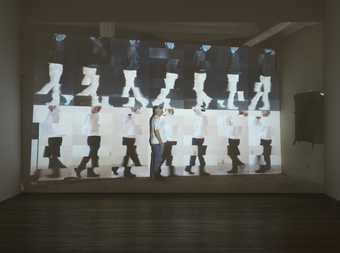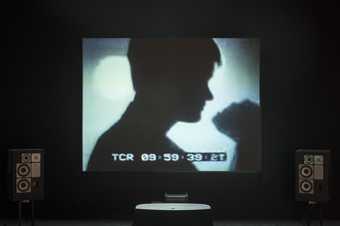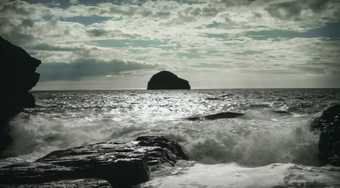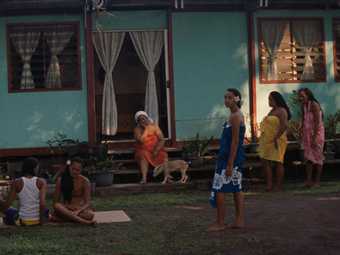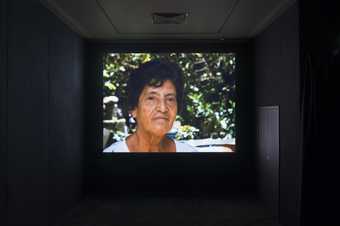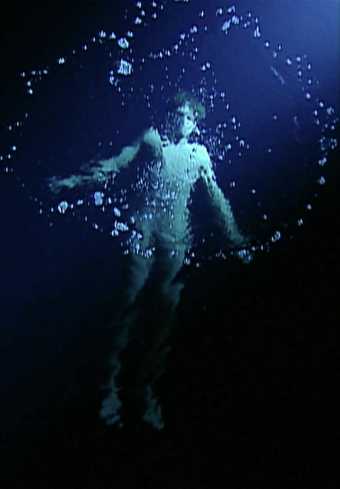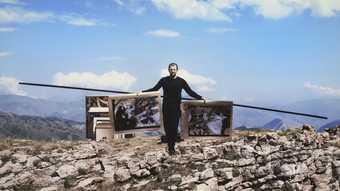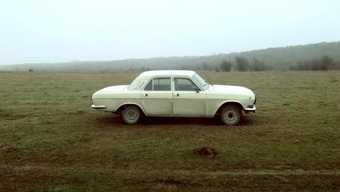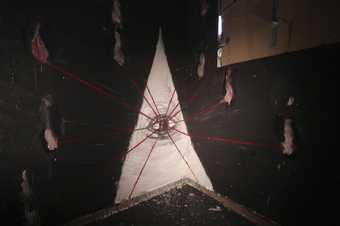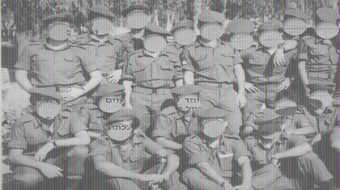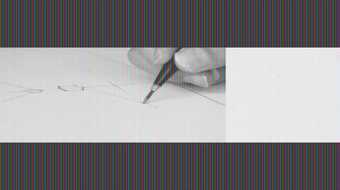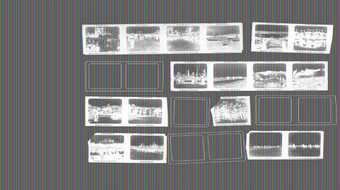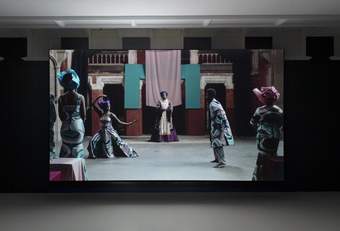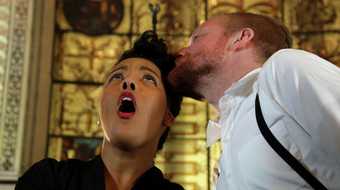Sorry, no image available
Not on display
- Artist
- Sophia Al-Maria born 1983
- Medium
- Video, high definition, projection, colour and sound (surround)
- Dimensions
- Duration: 38min, 3sec
- Collection
- Tate
- Acquisition
- Purchased with funds provided by Tate International Council 2021
- Reference
- T15761
Summary
Beast Type Song 2019 is a single-channel video with sound in which themes of language, education and writing are interwoven in an examination of the erasure and revision of identities and histories past and future. Shown as a projection and lasting just over thirty-eight minutes, the work is made up of a constellation of images, stories and histories that come together to form an abstract and changing landscape of conflict. The video comprises a collection of what Al-Maria describes as ‘revisions’ and borrows the visual language of script-editing to inform its structure. Just as a script’s separate returned revisions are distinguished by different colours, each act of Beast Type Song is marked by an asterisk on a differently coloured background: blue, pink, yellow, green, goldenrod, buff, salmon, cherry, tan. The video is composed of nine such revisions. An artist with experience in screenwriting, Al-Maria consciously uses her medium to shed light on realities that have been obscured. Form and content intermingle through the employment of scriptural revisions to address historical revisions. Beast Type Song was shot in the derelict former campus of Central Saint Martins School of Art and Design in Holborn, London, a site that holds an important legacy in the education of many prominent British artists.
Set against this backdrop are performances by Yumna Marwan, Elizabeth Peace and boychild, as well as by Al-Maria herself. The performances are woven together by the science-fiction meta-narrative of a solar battle, with Al-Maria evoking artist Etel Adnan’s (born 1925) war poem, ‘The Arab Apocalypse’, of 1989. In the poem, Adnan uses drawing to communicate what cannot be expressed in words. Similarly, Al-Maria explores the revision of history through graphic and bodily gestures. Beast Type Song narrates violence. When words cannot express trauma, a new language of drawings, movement and music gives voice to the speechless. Drawing on personal heritage and fictional future projections, the protagonists reflect on the narratives and languages they have inherited as children of various colonial legacies. Each protagonist encounters some form of violence, whether perpetrated physically, through the hostile gaze of the camera or the erasure of histories. These forms of violence sit in tandem. The viewer is told stories of a violence inflicted on the body, but at the same time must consider the violence of the storytelling itself: the violence of imposing a narrative, putting words into someone else’s mouth, inscribing their history for them.
In the video, Al-Maria considers how reality is constructed out of and through language. The limitations of words are brought forth in new languages of automatic scribbles, movement and mumbles. The project attempts to give voices to those who have been rendered speechless, such as the Sycorax in Shakespeare’s play The Tempest, or the actors who audition but are never cast for roles. Events and histories are revised and rewritten by each of the performers. The video also explores the possibility of escape from imposed narratives through poetry and glossolalia: the phenomenon of speaking in an unknown language. In the opening revision we hear children chanting: ‘A ram sam sam, a ram sam sam / Guli guli guli guli guli ram sam sam’. The words are from a Moroccan children’s song and game, but the chant has gained popularity around the world as a nonsense verse. While the words appear at first to be meaningless, their connection with the movement of the game suggests otherwise. In the inscription of these ‘nonsense’ words onto the body, the children find a translation that is corporeal, phenomenalised through gesture and freed from the constraints of written language and fixed meaning. Beast Type Song searches for a kind of understanding that is pre-conscious or primordial, a tacit language that supersedes one that is learned. It is through this intuitive understanding that its protagonists find the means to articulate narrative when words fail them.
Beast Type Song was first exhibited as part of the Art Now programme at Tate Britain between September 2019 and February 2020. It exists in an edition of three, of which this copy is number one.
Further reading
Sophia Al-Maria, Sad Sack: Collected Writing, London 2019.
Juliana Halpert, ‘Beast Type Song and Finding New Space in Language’, Artforum, 10 December 2019, https://www.artforum.com/interviews/sophia-al-maria-on-beast-type-song-81565, accessed 31 March 2020.
Nathan Ladd
March 2020
Does this text contain inaccurate information or language that you feel we should improve or change? We would like to hear from you.
You might like
-
Bruce Nauman Walks In Walks Out
2015 -
Mark Leckey Dream English Kid, 1964 - 1999 AD
2015 -
The Otolith Group Hydra Decapita
2010 -
Nashashibi/Skaer Why Are You Angry?
2017 -
Rosalind Nashashibi Vivian’s Garden
2017 -
Bill Viola The Messenger
1996 -
Taus Makhacheva Tightrope
2015 -
Aslan Ġoisum Volga
2015 -
Cristóbal León, Joaquín Cociña The Andes
2012 -
Dor Guez The Sick Man of Europe: The Painter
2015 -
Dor Guez The Sick Man of Europe: The Architect
2016 -
Dor Guez The Sick Man of Europe: The Composer
2017 -
Hetain Patel Don’t Look at the Finger
2017 -
Buhlebezwe Siwani Amahubo
2018 -
Sonia Boyce OBE Exquisite Cacophony
2015

